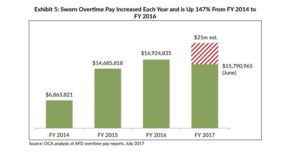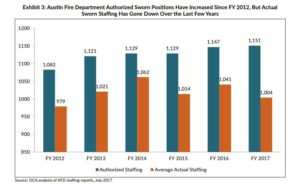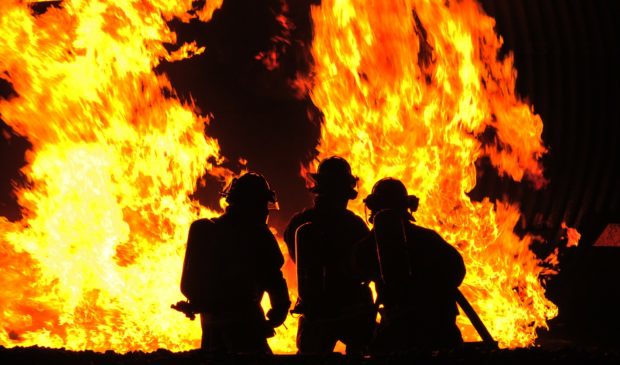Fire Department overtime soars to $21 million
Thursday, August 24, 2017 by
Jo Clifton Overtime pay for firefighters at the Austin Fire Department will reach about $21 million by the end of this fiscal year on Sept. 30 – a 206 percent increase since Fiscal Year 2013-14 – according to a report put out this week by the Office of the City Auditor in response to a request from City Council in June.
Total overtime pay grew by 147 percent between FY 2014, when it was $6.9 million, and Fiscal Year 2015-16, when it was $16.9 million, Fire Department officials report.
The department has routinely relied on overtime to meet its staffing requirements, “which seems to be a common practice in other fire departments,” the audit notes.
However, vacancies have exacerbated the increase in overtime pay since 2014, when the city entered into a federal consent decree aimed at increasing diversity within the ranks.
Fire Chief Rhoda Mae Kerr told the Austin Monitor on Wednesday that the department currently has 150 vacancies. On May 16, Kerr said, “On any given day we could have 175 people not reporting to work.” For example, she said at that time the department had 23 people out on family leave.

Auditors found that total sworn overtime pay increased by 147 percent from FY 2014 to FY 2016 and overtime hours worked went up by 124 percent during that same time frame.
Kerr said, “We have taken several steps to monitor the overtime and it’s pretty obvious that it is not people calling in sick that’s causing extreme overtime. It’s the fact that we have 150 vacancies and we are working as fast as we can with the restrictions that are put upon us by the (U.S. Department of Justice) to put as many classes as we can in service and get them graduated so that we can reduce the overtime,” Kerr said.
Auditors did find that firefighters took significantly more sick days on Saturday and Sunday than on other days, however.
Implementation of four-person staffing, which has been in place on all firefighter equipment since 2013, increased the need for more firefighters. But in addition, the overtime hourly rate for each fiscal year went up under a contract between the city and the Austin Firefighters Association. Auditors noted that the overtime rate increased by 6.5 percent in 2015, then by 3.5 percent in FY 2016 and another 1.6 percent for Fiscal Year 2016-17.
Council Member Jimmy Flannigan said the audit confirmed many things that he and Council Member Alison Alter have been learning. He said he is interested in putting an item on the budget concept menu that would go beyond questions of overtime pay.
Flannigan, who was elected with support from employee unions, including firefighters, said he would like to see the city “go back to the four-person staffing levels that were introduced in 2007.” In 2013, the city got a federal grant allowing four-person staffing on all equipment and the city has provided that level of staffing since then. (Firefighters supported former Council Member Don Zimmerman. An earlier version of this story said they supported Flannigan.)
“It could make a huge difference, especially when we have these high vacancies,” Flannigan said.
Austin Firefighters Association President Bob Nicks told the Monitor, “That’s a big safety line in the sand for us. That is not safe; we would be opposed. … That would be a serious, serious concern for the association if he was willing to reduce our safety in that manner.”
Nicks said that Flannigan might be confused about which equipment requires four-person staffing. He added, “I have a signed, written statement from Jimmy that he supports four-person staffing. That’s one place where we’re not flexible. I don’t think he has support on that from anybody on Council.”
Representatives for firefighters, police and emergency medical service are all currently negotiating new contracts with the city.
Nicks told the Monitor, “We are in the last throes of negotiations.” He said the 60-day period for negotiations is up. “And the city wanted to bring in a mediator.” He said the parties expect to negotiate again on Sept. 7, at which time “we’ll get an agreement or we’ll probably go to impasse.” The problem is only “a little bit about wages,” Nicks said. “We are advocating for a cost-of-living kind of contract, acknowledging that we are paid well and the city wants to go for a little less.”
In addition to the firefighters overtime audit, members of the city’s audit team looked at police and fire labor agreements to see how those are impacting overtime, among other things. The Special Report on Police and Fire Labor Agreement compared the fire departments in Austin, Fort Worth and Houston and noted that the departments “count productive time differently for the purpose of determining an employee’s eligibility for overtime in a work period.”
As City Auditor Corrie Stokes explained, firefighters work 24 hours on and 48 hours off, with a 19-day cycle. The 19th day of the cycle is known as a “Kelly day.” The final two days of the cycle are days off and the Kelly day is also a day off. Under the contract between Austin Firefighters Association and the city, people on their Kelly day get first preference for overtime, even though they have not been at work the two previous days. Stokes said that overtime preference can affect cost, but because there are so many vacancies in the department right now, it was probably not having that great an impact. Once the department has eliminated the vacancies, Stokes said, that contract provision may have more impact.
Nicks said firefighters would not be willing to agree to a change to the Kelly day preference, but they might be willing to make other changes to their work schedule.
Alter said she was interested in making some management changes that would include requiring firefighters to occasionally but regularly work on their Kelly days.

In addition, Alter said, “We have seen fire overtime triple. We know the root of the vacancy problems are the retirements and the consent decree. We have to ask if there are management choices that affect the cost of overtime and those are the questions that I’ve been asking. We need to do it a way that keeps professionals in our community safe, but there are fiscal implications.”
A new class of firefighters will be graduating at the end of September with 38 new department employees. Kerr said the department plans to have two new cadet classes starting in November.
Download (PDF, 249KB)
This story has been updated to more accurately reflect the Austin Firefighters Association’s position on work scheduling. It was also corrected to reflect that the AFA supported Flannigan’s opponent in the last election.
Graphs courtesy of the city of Austin.
The Austin Monitor’s work is made possible by donations from the community. Though our reporting covers donors from time to time, we are careful to keep business and editorial efforts separate while maintaining transparency. A complete list of donors is available here, and our code of ethics is explained here.
You're a community leader
And we’re honored you look to us for serious, in-depth news. You know a strong community needs local and dedicated watchdog reporting. We’re here for you and that won’t change. Now will you take the powerful next step and support our nonprofit news organization?












